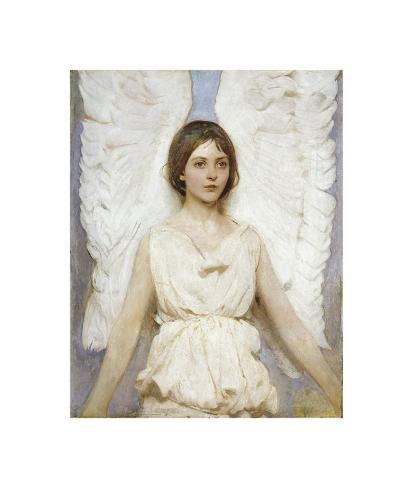Women and art is a very interesting combination, because
there are such varying, even conflicting, portrayals of the female form and
gender. The Newark Museum’s Angels and Tomboys: Girlhood in Nineteenth
Century American Art, a current exhibit, focuses on the depiction of women
in the 1800s. During this time period, and well into later centuries, women
were generally painted for the male gaze, making these representations women as
supplementary to the male figure or an object for them. The exhibit focuses on these representations
as a way to understand the female identity and its relation to (or rather
manifestation through) art.
 |
| Abott Henderson Thayer. Angel. 1887. |
Abott
Handerson Thayer, an American artist from New England, is displayed in the exhibit. In
the same spirit of his contemporaries, Thayer sought recognition through his
art and employed several naturalistic characteristics of artists at the time.
His main subject matter was, oddly enough, angels. Although his contemporaries
focused on less fantastical paintings, Thayer was deeply affected by his
marriage to his wife, Kate. After her father’s death, she suffered from an
intense fall into depression, or what they called melancholia in his day.
Relocating to rural New Hampshire in the efforts to treat his wife and avoid
the spread of tuberculosis, which festered in urban areas like a plague.
In his painting titled Angel, Thayer depicts a seemingly
beautiful but very solemn female figure.
In order to understand the tragically sublime reality of this painting,
it is important to be aware of Thayer’s family. He was very close to his
wife and children, and the painting is said to be a combination of his wife and
eldest daughter. Throughout the creation of the painting, his wife became ill
with consumption (what we call tuberculosis today); the disease was also
referred as the “angel of death” due to its incurable and lethal reputation.
The painting depicts a young female, innocent in nature, with chalky white skin
and ethereal wings, robes, and features. It is a representation of his daughter’s
innocence, his wife’s frailty, and his attachment to them.
 |
| Pablo Picasso. Three Women at the Spring. 1921. |
In contrast, Pablo Picasso depicted
women in a very different way. In Three Women at the Spring, he depicted
three women in classical garb. However, his painting was far from classical; as
a reaction to elite French standards of art, he painted his subject in highly
geometric style. Although referring to antiquity in the painting, his highly
stylistic representation of these women flirt with his Cubist tendencies. The
heaviness of their clothes, bodies, and structures overall give them a
monumental quality, all the while showing them in their own environment and existing
inside of their own reality. The idea of gender is involved, but not in the
sense which other artists involved it.
Picasso is truly showing the meaning of Modernism as a reaction to the
classical ideals of French art.
The depictions of the female in
both of these pieces are unique to the respective artist’s prerogative and
their environment at the time. Although painted by males, Thayer’s is
clearly painted for the male gaze and Picasso’s exists outside of that. Essentially,
the representation of gender was individual to the artist not necessarily the
time period. Throughout the Impressionist era, there were several artists that
painted women in relation to men but there were artists like Cassat who did
otherwise. In the case of Thayer and
Picasso, women are subject matter and the identity of the women in their
paintings is a culmination of their relationship to them and their relationship
to society.
Works Cited
Hunter, Sam, John Jacobs, and Daniel
Wheeler. Modern Art. New York: Prentice Hall PTR, 2004. Print.
Newark Museum. Angels & Tomboys:
Girlhood in 19th- Century American Art. Newark: Newark Museum, 2012.
No comments:
Post a Comment